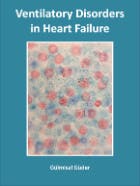Gulmisal Güder
Ventilatory disorders in heart failure

- Datum
- (Co) promotoren
- 11-04-2017
- prof.dr. A.W. Hoes, prof.dr. S. Störk, dr. F.H. Rutten
Samenvatting
Introduction: Chronic obstructive pulmonary disease (COPD), heart failure (HF) or both syndromes are the most common reasons for dyspnea in the elderly. Currently there is no standard to diagnose COPD and multiple definitions (fixed ratio [GOLD], lower limit of normal [LLN]) are discussed. Further, HF may impact on the results of pulmonary function testing (PFT), impeding proper diagnosis of pulmonary diseases. In this thesis, we aimed to elucidate important difficulties in diagnosing and grading of COPD in HF and to characterize other ventilatory disorders in HF. Methods: The results are based on two prospective cohort studies: the “UHFO-COPD-study” (N=405 patients with a general practitioner’s diagnosis of COPD) and the “INH-Study” (N=619 patients with HF with reduced ejection fraction [HFrEF]). Results: First, the diagnostic accuracy of the GOLD-COPD-definition and of three LLN-definitions were compared with the consensus diagnosis of an expert-panel, that used all available clinical and diagnostic information in the UHFO-COPD-study. Compared to the LLN-definitions, GOLD had the smallest number of misdiagnosis (‘GOLD-COPD’ 28%, three LLN-definitions 46%, 39%, and 40%), and was therefore used for all following studies to define COPD. Serially measured PFT results and COPD prevalence rates were compared in N=272 patients hospitalized for decompensated HFrEF in the INH-study. COPD, defined as non-reversible central airways obstruction (CAO) was present in 51/272(19%) of patients during hospitalization, but only in 24/51(47%) diagnosis could be reconfirmed 6 months later. Hyperinflation - a feature generally seen in COPD but not in HF –, predicted persisting COPD. Thus, a diagnosis of COPD in HF requires serial PFT under stable conditions or PFT including bodyplethysmography. Patients of the UHFO-COPD and the INH-study were divided into three groups: 1. HF only (N=557) 2. COPD only (N=108), and 3. HF+COPD (N=194). In patients with HF only, 25% exhibited forced expiratory volume in 1 sec (FEV1) levels of <80%. Compared with COPD only, patients with HF+COPD had higher levels of FEV1/forced vital capacity (FVC) and lower total lung capacity, but comparable FEV1-levels and thus similar distributions of GOLD stages I-IV in both groups (24/56/19/4% vs 31/50/19/1%, P=NS). Intake of beta-2-mimetics was associated with an increased mortality risk in patients with HF+COPD. Thus, classifying COPD based on FEV1 levels in HF may overrate obstruction severity, and provoke unnecessary and potentially harmful therapy. In HF, small airways obstruction (SAO) defined as maximum expiratory flow at 50% of FVC<60% of predicted is more common than CAO, but the prognostic relevance is unclear. In 585 patients with stable HFrEF, SAO was more common (N=226, 39%) as CAO (N=88, 15%), but had similar predictive utility. Further in N=162 patients with exclusion of COPD and without previously known HF, SAO was able to uncover HF and predict future pulmonary events as hospitalizations for pulmonary reasons and pneumonia. Conclusions: In patients with HF, SAO and CAO are common and both associated with increased mortality risk. Diagnosing and severity grading of COPD in HF is hampered for different reasons. Adding bodyplethysmography to PFT and performing PFT under stable conditions may increase accuracy of COPD diagnosis in HF.
